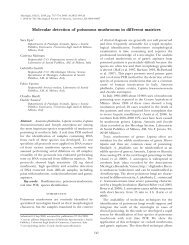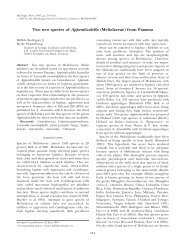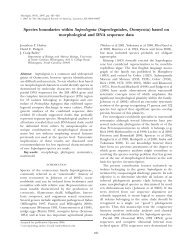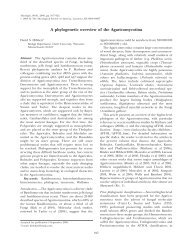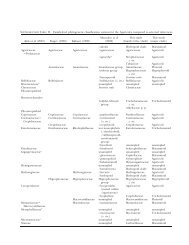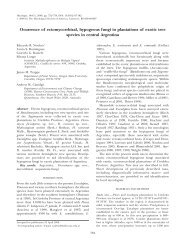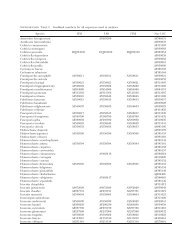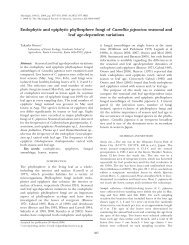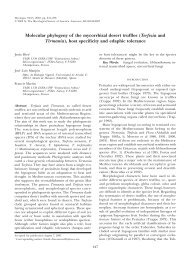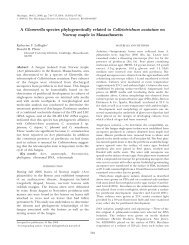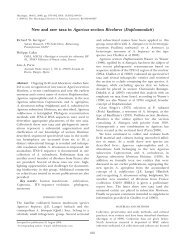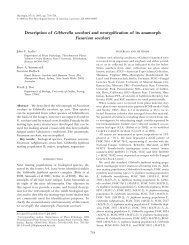Systematic reappraisal of species in Phoma section ... - Mycologia
Systematic reappraisal of species in Phoma section ... - Mycologia
Systematic reappraisal of species in Phoma section ... - Mycologia
You also want an ePaper? Increase the reach of your titles
YUMPU automatically turns print PDFs into web optimized ePapers that Google loves.
<strong>Mycologia</strong>, 102(5), 2010, pp. 1066–1081. DOI: 10.3852/09-240<br />
# 2010 by The Mycological Society <strong>of</strong> America, Lawrence, KS 66044-8897<br />
<strong>Systematic</strong> <strong>reappraisal</strong> <strong>of</strong> <strong>species</strong> <strong>in</strong> <strong>Phoma</strong> <strong>section</strong><br />
Paraphoma, Pyrenochaeta and Pleurophoma<br />
Johannes de Gruyter 1<br />
Plant Protection Service, P.O. Box 9102, 6700 HC<br />
Wagen<strong>in</strong>gen, the Netherlands<br />
Joyce H.C. Woudenberg<br />
Maikel M. Aveskamp<br />
Gerard J.M. Verkley<br />
Johannes Z. Groenewald<br />
Pedro W. Crous<br />
CBS-KNAW Fungal Biodiversity Centre, P.O. Box<br />
85167, 3508 AD Utrecht, the Netherlands<br />
Abstract: Sequence data from the 18S nrDNA (SSU)<br />
and 28S nrDNA (LSU) regions <strong>of</strong> isolates <strong>of</strong> <strong>Phoma</strong><br />
<strong>section</strong> Paraphoma were compared with those <strong>of</strong><br />
representative isolates <strong>of</strong> the morphologically similar<br />
anamorph genera Pleurophoma and Pyrenochaeta and<br />
<strong>of</strong> the type <strong>species</strong> <strong>of</strong> <strong>Phoma</strong> <strong>section</strong>s <strong>Phoma</strong>, Pilosa<br />
and Plenodomus. <strong>Phoma</strong> <strong>section</strong> Paraphoma was found<br />
to be highly polyphyletic with<strong>in</strong> the Pleosporales and<br />
only distantly related to <strong>Phoma</strong> <strong>section</strong> <strong>Phoma</strong>. The<br />
genus Paraphoma, which is based on Paraphoma<br />
radic<strong>in</strong>a, is re<strong>in</strong>troduced <strong>in</strong> the Phaeosphaeriaceae<br />
with two additional taxa. The new genera Setophoma<br />
and Neosetophoma, type <strong>species</strong> Setophoma terrestris<br />
comb. nov. and Neosetophoma samarorum comb. nov.,<br />
are <strong>in</strong>troduced and represent <strong>species</strong> that are closely<br />
related to Paraphoma but differ based on morphological<br />
characters and molecular phylogeny. <strong>Phoma</strong><br />
coonsii is transferred to genus Chaetosphaeronema that<br />
also belongs to the Phaeosphaeriaceae. Pyrenochaetopsis<br />
gen. nov. is <strong>in</strong>troduced to accommodate the<br />
type <strong>species</strong> Pyrenochaetopsis leptospora comb. nov., as<br />
well as several other <strong>species</strong> formerly accommodated<br />
<strong>in</strong> <strong>Phoma</strong> and Pyrenochaeta. Pyrenochaetopsis is closely<br />
related to Pyrenochaeta and classified <strong>in</strong> the Cucurbitariaceae.<br />
Pleurophoma cava is transferred to genus<br />
Pyrenochaeta. The new genera elucidate the confus<strong>in</strong>g<br />
taxonomy <strong>of</strong> <strong>species</strong> <strong>in</strong> genera <strong>Phoma</strong>, Pyrenochaeta<br />
and Pleurophoma and recognize monophyletic genera<br />
with dist<strong>in</strong>ct teleomorph aff<strong>in</strong>ities.<br />
Key words: coelomycetes, 18S nrDNA, molecular<br />
phylogeny, Pleosporales, Pyrenochaetopsis gen. nov,<br />
Setophoma gen. nov, 28S nrDNA, Neosetophoma gen.<br />
nov<br />
Submitted 29 Sep 2009; accepted for publication 10 Dec 2009.<br />
1 Correspond<strong>in</strong>g author. E-mail: j.de.gruyter@m<strong>in</strong>lnv.nl<br />
1066<br />
INTRODUCTION<br />
Asexual ascomycetes produc<strong>in</strong>g ostiolate pycnidia<br />
with hyal<strong>in</strong>e conidia have been classified <strong>in</strong> a number<br />
<strong>of</strong> coelomycetous genera. These genera are separated<br />
ma<strong>in</strong>ly on a comb<strong>in</strong>ation <strong>of</strong> conidiomatal anatomy,<br />
conidiogenesis and conidial morphology. The genus<br />
<strong>Phoma</strong> takes a prom<strong>in</strong>ent position among these<br />
genera because it <strong>in</strong>corporates many important plant<br />
pathogenic <strong>species</strong>. The nearly 220 <strong>Phoma</strong> <strong>species</strong><br />
that are recognized currently (Boerema et al. 2004)<br />
were classified <strong>in</strong> n<strong>in</strong>e <strong>section</strong>s accord<strong>in</strong>g to pycnidial,<br />
conidial and cultural characters. Some <strong>of</strong> these<br />
<strong>section</strong>s are highly artificial from an evolutionary<br />
perspective, and overlapp<strong>in</strong>g characters among <strong>section</strong>s<br />
as well as with other genera <strong>of</strong> coelomycetes do<br />
occur (Boerema et al. 2004, Aveskamp et al. 2008).<br />
The genus <strong>Phoma</strong> is characterized by hyal<strong>in</strong>e,<br />
unicellular conidia that may become septate due to<br />
secondary septation, phialidic, ampulliform to doliiform<br />
conidiogenous cells and (sub)globose, glabrous<br />
to pilose or setose, pseudoparenchymatous or scleroplectenchymatous<br />
pycnidia. Six <strong>Phoma</strong> <strong>section</strong>s<br />
<strong>in</strong>clude <strong>species</strong> with a known teleomorph <strong>in</strong> the<br />
genera Didymella, Leptosphaeria or Pleospora, <strong>in</strong>dicat<strong>in</strong>g<br />
the genetic diversity <strong>in</strong> genus <strong>Phoma</strong> (van der Aa<br />
et al. 1990, Boerema 1997). A recent molecular study<br />
demonstrated that the type <strong>species</strong> <strong>of</strong> all <strong>Phoma</strong><br />
<strong>section</strong>s grouped <strong>in</strong> the Pleosporales. The representatives<br />
<strong>of</strong> five <strong>section</strong>s clustered <strong>in</strong> the new family<br />
Didymellaceae, <strong>in</strong>clud<strong>in</strong>g <strong>Phoma</strong> herbarum, the type<br />
<strong>species</strong> <strong>of</strong> genus <strong>Phoma</strong> (de Gruyter et al. 2009).<br />
<strong>Phoma</strong> radic<strong>in</strong>a, the type <strong>species</strong> <strong>of</strong> <strong>Phoma</strong> sect.<br />
Paraphoma, clustered with <strong>species</strong> classified <strong>in</strong> the<br />
Phaeosphaeriaceae (de Gruyter et al. 2009). <strong>Phoma</strong><br />
sect. Paraphoma is delimited <strong>in</strong> the genus <strong>Phoma</strong> by its<br />
setose, pseudoparenchymatous pycnidia. The characteristics<br />
<strong>of</strong> the setae (viz. stiff or more hyphal-like)<br />
and their length and position on the pycnidial surface<br />
are important for further <strong>species</strong> delimitation (de<br />
Gruyter and Boerema 2002). Species with setose<br />
pycnidia produc<strong>in</strong>g hyal<strong>in</strong>e conidia also were classified<br />
<strong>in</strong> other genera, particularly Pyrenochaeta, for<br />
which the branched, filiform, septate, acropleurogenous<br />
conidiophores were considered the most important<br />
delimitat<strong>in</strong>g character (Schneider 1979). However<br />
Pyrenochaeta <strong>species</strong> have been described with<br />
setose pycnidia but with a <strong>Phoma</strong>-like conidiogenesis<br />
such as the Pyrenochaeta romeroi, which <strong>in</strong> rare cases<br />
causes human <strong>in</strong>fections (Borelli 1959). Setose
pycnidia also have been reported rarely <strong>in</strong> other<br />
<strong>Phoma</strong> <strong>section</strong>s, such as <strong>in</strong> the generic type <strong>species</strong><br />
<strong>Phoma</strong> herbarum and <strong>in</strong> <strong>Phoma</strong> glomerata (Boerema et<br />
al. 2004). Furthermore <strong>Phoma</strong> <strong>species</strong> such as <strong>Phoma</strong><br />
clematid<strong>in</strong>a, produc<strong>in</strong>g pycnidia with hyphal outgrowths<br />
resembl<strong>in</strong>g setose pycnidia, have been<br />
described and classified <strong>in</strong> the Didymellaceae (Woudenberg<br />
et al. 2009). In the related genus Pleurophoma<br />
both types <strong>of</strong> conidiogenesis may be present<br />
but <strong>species</strong> attributed to this genus produce glabrous<br />
pycnidia.<br />
The classification <strong>of</strong> several <strong>species</strong> <strong>in</strong> the genera<br />
Pyrenochaeta, Pleurophoma and <strong>Phoma</strong> sect. Paraphoma<br />
has been disputed because <strong>of</strong> the overlapp<strong>in</strong>g<br />
characters <strong>of</strong> conidiogenesis and setose pycnidia<br />
(Schneider 1979, Grondona et al. 1997). The<br />
teleomorphs <strong>of</strong> <strong>Phoma</strong> <strong>section</strong> Paraphoma and<br />
Pleurophoma are still unknown, whereas <strong>in</strong> the genus<br />
Pyrenochaeta two <strong>species</strong> have been associated with a<br />
teleomorph, Py. parasitica (teleom. Herpotrichia<br />
parasitica, von Freyer and van der Aa 1975) and Py.<br />
berberidis (teleom. Cucurbitaria berberidis [Pers.] S.F.<br />
Gray, Sivanesan 1984). Pyrenochaeta berberidis was<br />
excluded from the genus by Schneider (1979)<br />
because the pycnidial characteristics were different<br />
and setose pycnidia proved not to be a stable<br />
character. The multiple teleomorphs and the overlapp<strong>in</strong>g<br />
morphological characters suggest that these<br />
anamorph genera are polyphyletic.<br />
To clarify the systematics <strong>of</strong> these groups, DNA<br />
sequence data <strong>of</strong> the SSU and LSU regions <strong>of</strong> 61<br />
isolates represent<strong>in</strong>g the <strong>species</strong> currently classified <strong>in</strong><br />
<strong>Phoma</strong> <strong>section</strong> Paraphoma, Pyrenochaeta and Pleurophoma<br />
were compared with those <strong>of</strong> 19 isolates<br />
represent<strong>in</strong>g related genera. The taxonomy <strong>of</strong> <strong>species</strong><br />
<strong>in</strong> <strong>Phoma</strong> <strong>section</strong> Paraphoma, Pyrenochaeta and<br />
Pleurophoma is redef<strong>in</strong>ed, a classification at family<br />
level <strong>in</strong>dicated and related teleomorph genera<br />
identified.<br />
MATERIALS AND METHODS<br />
Isolate selection, cultural studies and DNA extraction.—<br />
Generic abbreviations <strong>in</strong> this study <strong>in</strong>clude Paraphoma (Pa),<br />
<strong>Phoma</strong> (Ph), Pleurophoma (Pl), Pyrenochaeta (Py), Pyrenochaetopsis<br />
(Pyr) and Setophoma (S). Freeze-dried isolates<br />
were obta<strong>in</strong>ed from the culture collections <strong>of</strong> Centraalbureau<br />
voor Schimmelcultures (CBS) and the Dutch National<br />
Reference Laboratory <strong>of</strong> the Plant Protection Service (PD)<br />
(TABLE I). Isolates were revived overnight <strong>in</strong> 2 mL malt/<br />
peptone (50/50%) liquid medium. Isolates were transferred<br />
and ma<strong>in</strong>ta<strong>in</strong>ed on oatmeal agar (OA) (Crous et al.<br />
2009). Cultures grow<strong>in</strong>g on OA, malt extract agar (MEA)<br />
and cherry-decoction agar (CHA) were studied morphologically<br />
as described <strong>in</strong> Boerema et al. (2004). DNA extraction<br />
was conducted with the Ultraclean Microbial DNA Isolation<br />
DE GRUYTER ET AL.: REAPPRAISAL OF SPECIES IN PHOMA 1067<br />
Kit (Mo Bio Laboratories, Carlsbad, California) accord<strong>in</strong>g<br />
to manufacturer <strong>in</strong>structions. All DNA extracts were diluted<br />
10 times <strong>in</strong> milliQ water and stored at 4 C before use.<br />
PCR and sequenc<strong>in</strong>g.—The SSU region was amplified with<br />
primers NS1 and NS4 (White et al. 1990), and the LSU<br />
region was amplified with primers LR0R (Rehner and<br />
Samuels 1994) and LR7 (Vilgalys and Hester 1990). PCR<br />
was performed and analyzed as described by de Gruyter et<br />
al. (2009). Sequenc<strong>in</strong>g <strong>of</strong> the PCR amplicons was conducted<br />
with the same primer comb<strong>in</strong>ations, although LR5 was used<br />
as an additional sequenc<strong>in</strong>g primer for LSU (Vilgalys and<br />
Hester 1990). Sequence products were purified with<br />
Sephadex G-50 Superf<strong>in</strong>e (Amersham Biosciences, Roosendaal,<br />
the Netherlands) and analyzed with an ABI Prism 3730<br />
3 L Sequencer (Applied Biosystems) accord<strong>in</strong>g to manufacturer<br />
<strong>in</strong>structions. Consensus sequences were computed<br />
from both forward and reverse sequences with the<br />
Bionumerics 4.61 s<strong>of</strong>tware package (Applied Maths, S<strong>in</strong>t-<br />
Martens-Latem, Belgium) and were lodged with GenBank.<br />
Phylogenetic analyses.—Sequence data <strong>of</strong> 61 cultures generated<br />
<strong>in</strong> this study were aligned with sequences <strong>of</strong> 19 cultures<br />
obta<strong>in</strong>ed from GenBank (TABLE I). The alignment was<br />
calculated automatically by the BioNumerics s<strong>of</strong>tware<br />
package, but manual adjustments for improvement were<br />
made by eye where necessary. The phylogeny was rooted to<br />
Sporormiella m<strong>in</strong>ima (CBS 524.50). The phylogenetic<br />
analyses were done for each dataset and based on similar<br />
tree topologies obta<strong>in</strong>ed, as well as with a comb<strong>in</strong>ed<br />
alignment consist<strong>in</strong>g <strong>of</strong> both SSU and LSU regions. A<br />
neighbor jo<strong>in</strong><strong>in</strong>g (NJ) distance analysis was conducted with<br />
PAUP* 4b10 (Sw<strong>of</strong>ford 2003) with the uncorrected ‘‘p’’,<br />
Jukes-Cantor and Kimura 2-parameter substitution models.<br />
The robustness <strong>of</strong> the trees was evaluated by 1000 bootstrap<br />
replications. A Bayesian analysis was conducted with<br />
MrBayes 3.1.2 (Huelsenbeck and Ronqvist 2001) <strong>in</strong> two<br />
parallel runs, us<strong>in</strong>g the default sett<strong>in</strong>gs but with these<br />
adjustments: GTR model with gamma-distributed rate was<br />
selected for both partitions with F<strong>in</strong>dmodel freeware<br />
(http://hcv.lanl.gov/content/hcv-db/f<strong>in</strong>dmodel/f<strong>in</strong>dmodel.<br />
html), and a MCMC heated cha<strong>in</strong> was set with a temperature<br />
value <strong>of</strong> 0.05. The number <strong>of</strong> generations, sample frequencies<br />
and burn-<strong>in</strong> ratio were set respectively at 5 000 000, 10 and 0.1;<br />
the run was stopped automatically as soon as the average<br />
standard deviation <strong>of</strong> split frequencies fell below 0.01. Trees<br />
were pr<strong>in</strong>ted with TreeView 1.6.6 (Page 1996) and alignments<br />
and trees are lodged with TreeBase (www.treebase.org),<br />
<strong>in</strong>clud<strong>in</strong>g those trees that were obta<strong>in</strong>ed for the s<strong>in</strong>gle SSU<br />
and LSU datasets.<br />
RESULTS<br />
The aligned sequence matrix obta<strong>in</strong>ed for the SSU<br />
and LSU regions had a total length <strong>of</strong> 2633<br />
nucleotide characters, 1332 (positions 1–1332 <strong>in</strong> the<br />
TreeBase alignment) and 1301 (positions 1333–2633<br />
<strong>in</strong> the TreeBase alignment) respectively. In the<br />
alignment an <strong>in</strong>sertion <strong>in</strong> the SSU at positions 440–<br />
796 was observed for two cultures <strong>of</strong> Phialophora
1068 MYCOLOGIA<br />
TABLE I. Fungal isolates <strong>in</strong>cluded for SSU and LSU analysis<br />
GenBank accession<br />
Host, substrate Country<br />
SSU LSU<br />
Species name,<br />
f<strong>in</strong>al identification Formerly identified Stra<strong>in</strong> number<br />
Chaetodiplodia sp. CBS 568.88 EU754043 EU754142 Rock Israel<br />
Chaetopyrena penicillata CBS 498.72 GQ387512 GQ387573 Medicago sativa<br />
South Africa<br />
(Legum<strong>in</strong>osae-Papilionoideae)<br />
CBS 199.89 GQ387513 GQ387574 soil Turkey<br />
Chaetosphaeronema <strong>Phoma</strong> coonsii CBS 141.84 (T), CECT GQ387514 GQ387575 Malus sylvestris (Rosaceae) Japan, Mazoika<br />
coonsii comb. nov.<br />
20047, PD 78/241,<br />
ATCC 56513<br />
Chaetosphaeronema<br />
CBS 216.75 EU754045 EU754144 Anthyllis vulneraria<br />
Germany<br />
hispidulum (TS)<br />
(Legum<strong>in</strong>osae-Papilionoideae)<br />
Leptosphaeria doliolum<br />
CBS 505.75 GQ387515 GQ387576 Urtica dioica (Urticaceae) Netherlands<br />
subsp. doliolum (teleom.)<br />
Neophaeosphaeria<br />
CBS 102202 GQ387516 GQ387577 Yucca rostrata (Agavaceae) Mexico<br />
filamentosa (teleom.)<br />
Neosetophoma samarorum <strong>Phoma</strong> samarorum CBS 568.94 GQ387519 GQ387580 Urtica dioica (Urticaceae) Netherlands<br />
comb. nov.<br />
<strong>Phoma</strong> samarorum CBS 138.96,<br />
GQ387517 GQ387578 Phlox paniculata (Polemoniaceae) Netherlands<br />
PD 82/653<br />
<strong>Phoma</strong> samarorum CBS 139.96,<br />
GQ387518 GQ387579 (Gram<strong>in</strong>ae) Netherlands<br />
PD 82/905<br />
Ophiosphaerella herpotricha<br />
CBS 240.31, ATCC DQ767650 DQ767656 unknown France<br />
(teleom.)<br />
12279<br />
Paraconiothyrium m<strong>in</strong>itans CBS 122788,<br />
EU754074 EU754173 unknown United K<strong>in</strong>gdom<br />
PD 07/03486739<br />
Paraconiothyrium sp. Pleurophoma pleurospora CBS 101461 EU754101 EU754200 man, cutaneous lesions USA, Texas<br />
Paraphaeosphaeria michoti<br />
CBS 652.86 GQ387520 GQ387581 Typha latifolia (Typhaceae) Switzerland<br />
(teleom.)<br />
Paraphoma<br />
<strong>Phoma</strong> chrysanthemicola CBS 522.66 (NT) GQ387521 GQ387582 Chrysanthemum morifolium United K<strong>in</strong>gdom<br />
chrysanthemicola comb.<br />
(Asteraceae)<br />
nov.<br />
<strong>Phoma</strong> chrysanthemicola CBS 172.70 GQ387522 GQ387583 Chrysanthemum morifolium Germany<br />
(Asteraceae)<br />
Paraphoma fimeti comb. <strong>Phoma</strong> fimeti CBS 170.70 (NT), IMI GQ387523 GQ387584 Apium graveolens (Apiaceae) Netherlands<br />
nov.<br />
163514, ATCC 22707<br />
<strong>Phoma</strong> fimeti CBS 368.91, PD<br />
GQ387524 GQ387585 Juniperus communis<br />
Switzerland<br />
78/1096<br />
(Cupressaceae)<br />
Paraphoma radic<strong>in</strong>a (TS) <strong>Phoma</strong> radic<strong>in</strong>a CBS 111.79, IMI<br />
EU754092 EU754191 Malus sylvestris (Rosaceae) Netherlands<br />
386094, PD 76/437<br />
<strong>Phoma</strong> radic<strong>in</strong>a CBS 102875, PD 78/ EU754091 EU754190 Lycopersicum esculentum Germany<br />
1097<br />
(Solanaceae)<br />
<strong>Phoma</strong> terrestris CBS 377.52, ATCC 11321 GQ387527 GQ387588 Allium cepa (Alliaceae) Unknown<br />
CBS 335.87 GQ387528 GQ387589 Allium cepa (Alliaceae) Senegal
TABLE I. Cont<strong>in</strong>ued<br />
DE GRUYTER ET AL.: REAPPRAISAL OF SPECIES IN PHOMA 1069<br />
GenBank accession<br />
Species name,<br />
f<strong>in</strong>al identification Formerly identified Stra<strong>in</strong> number<br />
SSU LSU<br />
Host, substrate Country<br />
Phaeosphaeria caricicola<br />
CBS 603.86 GQ387529 GQ387590 Carex pendula (Cyperaceae) Switzerland<br />
(teleom.)<br />
Phaeosphaeria nodorum<br />
CBS 110109 EU754076 EU754175 Lolium perenne (Gram<strong>in</strong>eae) Denmark<br />
(teleom.)<br />
Phaeosphaeria oryzae (teleom.) CBS 110110 GQ387530 GQ387591 Oryza sativa (Oryzeae) South Korea<br />
Phaeosphaeriopsis glauco-<br />
CBS 653.86 GQ387531 GQ387592 Ruscus aculeatus (Ruscaceae) Switzerland<br />
punctata (teleom.)<br />
<strong>Phoma</strong> betae, teleom.<br />
CBS 109410, PD 77/113 EU754079 EU754178 Beta vulgaris (Chenopodiaceae) Netherlands<br />
Pleospora betae<br />
<strong>Phoma</strong> carteri CBS 101633, PD 84/74 GQ387532 GQ387593 Quercus sp. Fagaceae) Netherlands<br />
CBS 105.91 GQ387533 GQ387594 Quercus robur (Fagaceae) Germany<br />
<strong>Phoma</strong> gardeniae CBS 626.68, IMI 108771 GQ387534 GQ387595 Gardenia jasm<strong>in</strong>oides<br />
India<br />
(Rubiaceae)<br />
CBS 302.79, PD 79/1156 GQ387535 GQ387596 airborne Netherlands<br />
Antilles<br />
<strong>Phoma</strong> glyc<strong>in</strong>icola CBS 124455, IMI 294986 GQ387536 GQ387597 Glyc<strong>in</strong>e max (Legum<strong>in</strong>osae- Zambia<br />
Papilionoideae)<br />
CBS 124141, PG-1 GQ387537 GQ387598 Glyc<strong>in</strong>e max (Legum<strong>in</strong>osae- Zimbabwe<br />
Papilionoideae)<br />
<strong>Phoma</strong> herbarum (TS) CBS 615.75, IMI 199779 EU754087 EU754186 Rosa multiflora (Rosaceae), Netherlands<br />
<strong>Phoma</strong> l<strong>in</strong>gam, teleom.<br />
DAOM 229267 DQ470993 DQ470946 Brassica sp. (Brassicaceae) unknown<br />
Leptosphaeria maculans<br />
<strong>Phoma</strong> septicidalis CBS 188.71 GQ387538 GQ387599 air F<strong>in</strong>land<br />
CBS 856.97 GQ387539 GQ387600 m<strong>in</strong>eral wool F<strong>in</strong>land<br />
CBS 101636, PD 86/1186 GQ387540 GQ387601 Glyc<strong>in</strong>e max (Legum<strong>in</strong>osae- Zimbabwe<br />
Papilionoideae)<br />
Pyrenochaeta acicola <strong>Phoma</strong> leveillei var. CBS 812.95 GQ387541 GQ387602 waterpipe Netherlands<br />
leveillei<br />
<strong>Phoma</strong> leveillei var. CBS 101634, PD 76/416 GQ387542 GQ387603 Fragaria (x) ananassa<br />
Netherlands<br />
leveillei<br />
(Rosaceae)<br />
<strong>Phoma</strong> leveillei var. CBS 124142, PD 70/407 GQ387543 GQ387604 Fragaria (x) ananassa<br />
Netherlands<br />
leveillei<br />
(Rosaceae)<br />
CBS 394.84 GQ387544 GQ387605 Berberis julianae<br />
Netherlands<br />
(Berberidaceae)<br />
CBS 363.93 GQ387545 GQ387606 Berberis vulgaris<br />
Netherlands<br />
(Berberidaceae)<br />
Pleurophoma cava CBS 257.68, IMI 331911 EU754100 EU754199 wheat field soil Germany<br />
Pleurophoma cava CBS 115953 GQ387546 GQ387607 Quercus cerris Italy<br />
Pyrenochaeta berberidis,<br />
teleom. Cucurbitaria<br />
berberidis<br />
Pyrenochaeta cava comb.<br />
nov.
1070 MYCOLOGIA<br />
TABLE I. Cont<strong>in</strong>ued<br />
GenBank accession<br />
Host, substrate Country<br />
SSU LSU<br />
Species name,<br />
f<strong>in</strong>al identification Formerly identified Stra<strong>in</strong> number<br />
Pyrenochaeta corni CBS 248.79 GQ387547 GQ387608 Frax<strong>in</strong>us excelsior (Oleaceae) Netherlands<br />
Phialophorophoma CBS 234.92 EU754077 EU754176 Olea europaea (Oleaceae) Italy<br />
litoralis (TS)<br />
Phialophorophoma CBS 102828 GQ387548 GQ387609 Olea europaea (Oleaceae) Italy<br />
litoralis<br />
Pyrenochaeta dolichi CBS 124143, IMI 217261 GQ387549 GQ387610 Dolichos biforus (Legum<strong>in</strong>osae- India<br />
Papilionoideae)<br />
CBS 124140, IMI 217262 GQ387550 GQ387611 Dolichos biforus (Legum<strong>in</strong>osae- India<br />
Papilionoideae)<br />
Pyrenochaeta lycopersici CBS 267.59 GQ387551 GQ387612 Lycopersicon esculentum<br />
Netherlands<br />
(Solanaceae)<br />
CBS 306.65 EU754106/ EU754205 Lycopersicon esculentum<br />
Germany<br />
DQ898289<br />
(Solanaceae)<br />
Pyrenochaeta mack<strong>in</strong>nonii CBS 674.75 (T) Q387552 GQ387613 black gra<strong>in</strong> mycetoma, man Venezuela<br />
CBS 110022 GQ387553 GQ387614 mycetoma <strong>of</strong> patient Mexico<br />
Pyrenochaeta nobilis var. ilicis CBS 292.74 GQ387554 GQ387615 Ilex aquifolium (Aquifoliaceae), Netherlands<br />
Pyrenochaeta nobilis CBS 566.75 GQ387555 GQ387616 Buxus sempervirens (Buxaceae) Netherlands<br />
CBS 407.76 (NT) EU754107/ EU754206 Laurus nobilis (Lauraceae) Italy<br />
DQ898287<br />
Pyrenochaeta parasitica,<br />
CBS 451.73 (T) GQ387556 GQ387617 Abies alba (P<strong>in</strong>aceae) Germany<br />
teleom Herpotrichia<br />
CBS 218.77 GQ387557 GQ387618 Abies alba (P<strong>in</strong>aceae) Germany<br />
parasitica<br />
Pyrenochaeta querc<strong>in</strong>a CBS 115095 GQ387558 GQ387619 Quercus robur (Fagaceae) Italy<br />
Pyrenochaeta querc<strong>in</strong>a Phialophorophoma CBS 297.74 GQ387559 GQ387620 Sea water Montenegro<br />
litoralis<br />
Pyrenochaeta romeroi CBS 252.60 (T), ATCC EU754108 EU754207 maduromycosis <strong>in</strong> man Venezuela<br />
13735<br />
CBS 122784, PD 84/1022 EU754109 EU754208 Hordeum vulgare (Gram<strong>in</strong>eae) unknown<br />
Pyrenochaeta unguis-hom<strong>in</strong>is CBS 378.92, IMI 227230 GQ387560 GQ387621 man, f<strong>in</strong>gernail United K<strong>in</strong>gdom<br />
<strong>Phoma</strong> septicidalis CBS 112.79, IMI 386095, GQ387561 GQ387622 airborn United K<strong>in</strong>gdom<br />
PD 74/1018<br />
<strong>Phoma</strong> leveillei var. CBS 111112 GQ387562 GQ387623 Agapornis sp. (Aves), lung Netherlands<br />
leveillei<br />
Pyrenochaetopsis decipiens <strong>Phoma</strong> terricola CBS 343.85, IMI 386097 GQ387563 GQ387624 Globodera pallida, cyst Netherlands<br />
comb. nov.<br />
<strong>Phoma</strong> terricola CBS 165.89 GQ387564 GQ387625 Hordeum vulgare (Gram<strong>in</strong>eae) Netherlands<br />
Pyrenochaetopsis <strong>in</strong>dica comb. <strong>Phoma</strong> <strong>in</strong>dica CBS 124454, IMI<br />
GQ387565 GQ387626 Saccharum <strong>of</strong>fic<strong>in</strong>alum (Poaceae) India<br />
nov.<br />
062569(b) (T)
TABLE I. Cont<strong>in</strong>ued<br />
GenBank accession<br />
Host, substrate Country<br />
SSU LSU<br />
Species name,<br />
f<strong>in</strong>al identification Formerly identified Stra<strong>in</strong> number<br />
DE GRUYTER ET AL.: REAPPRAISAL OF SPECIES IN PHOMA 1071<br />
Pyrenochaetopsis leptospora <strong>Phoma</strong> briardii CBS 101635 (T), PD GQ387566 GQ387627 Secale cereale (Gram<strong>in</strong>ae) Europe<br />
comb. nov.<br />
71/1027<br />
Pyrenochaeta aciicola CBS 122789, PD 07/ EU754105 EU754204 Hordeum vulgare (Gram<strong>in</strong>eae) unknown<br />
03486800<br />
<strong>Phoma</strong> leveillei var. CBS 536.66 GQ387567 GQ387628 wheat field soil Germany<br />
leveillei<br />
<strong>Phoma</strong> leveillei var. CBS 131.69 GQ387568 GQ387629 dung <strong>of</strong> sheep Netherlands<br />
leveillei<br />
Pyrenochaetopsis microspora <strong>Phoma</strong> leveillei var. CBS 101333 GQ387569 GQ387630 Buellia (lichen, ascomata) Ch<strong>in</strong>a<br />
comb. nov.<br />
microspora<br />
<strong>Phoma</strong> leveillei var. CBS 102876 (T), PD GQ387570 GQ387631 water Montenegro<br />
microspora<br />
75/911<br />
<strong>Phoma</strong> leveillei var. CBS 119739 GQ387571 GQ387632 C<strong>of</strong>fea arabica (Rubiaceae) Brazil<br />
microspora<br />
Setamelanomma holmii<br />
CBS 110217 GQ387572 GQ387633 Picea pungens (P<strong>in</strong>aceae) USA, Wiscons<strong>in</strong><br />
(teleom.)<br />
Setophoma sacchari comb. <strong>Phoma</strong> setariae CBS 333.39 GQ387525 GQ387586 Saccharum <strong>of</strong>fic<strong>in</strong>arum (Poaceae) Brazil<br />
nov.<br />
Setophoma terrestris comb. <strong>Phoma</strong> terrestris CBS 335.29 GQ387526 GQ387587 Allium sativum (Alliaceae) USA<br />
nov.<br />
Sporormiella m<strong>in</strong>ima CBS 524.50 DQ678003 DQ678056 dung <strong>of</strong> goat Panama<br />
T, Ex-type stra<strong>in</strong>.<br />
TS, Type <strong>species</strong> <strong>of</strong> the genus.<br />
NT, Ex-neotype stra<strong>in</strong>.
1072 MYCOLOGIA<br />
litoralis, <strong>Phoma</strong> samarorum and Pyrenochaeta mack<strong>in</strong>nonii,<br />
and a culture <strong>of</strong> Ophiosphaerella herpotricha<br />
(5 Ophiobolus herpotrichus), <strong>Phoma</strong> coonsii and<br />
Chaetosphaeronema hispidulum. This <strong>in</strong>sertion was<br />
excluded from further phylogenetic analyses. The<br />
comb<strong>in</strong>ed dataset <strong>in</strong> the analyses <strong>in</strong>cluded 80 taxa<br />
and conta<strong>in</strong>ed 2276 characters with 76 and 193<br />
unique site patterns for SSU and LSU respectively.<br />
The PAUP* NJ analyses with the three substitution<br />
models showed similar tree topologies.<br />
The analysis run <strong>in</strong> MrBayes resulted <strong>in</strong> 408 202<br />
trees after 2 041 000 generations, from which the<br />
burn-<strong>in</strong> was discarded and the consensus tree and<br />
posterior probabilities were calculated based on<br />
188 452 trees. For <strong>in</strong>dividual SSU and LSU alignments<br />
trees were compared by eye and the tree topology <strong>of</strong><br />
the <strong>in</strong>dividual datasets was similar to each other and<br />
to the tree obta<strong>in</strong>ed from the comb<strong>in</strong>ed alignment.<br />
The results <strong>of</strong> the PAUP* NJ analyses were congruent<br />
with those obta<strong>in</strong>ed <strong>in</strong> the Baysian analysis.<br />
The phylogenetic tree based on the comb<strong>in</strong>ed LSU<br />
and SSU sequence data calculated with MrBayes<br />
(FIG. 1) demonstrated that <strong>Phoma</strong> sect. Paraphoma<br />
was highly polyphyletic <strong>in</strong> that the taxa <strong>in</strong>volved<br />
segregated <strong>in</strong>to four dist<strong>in</strong>ct clades <strong>in</strong> the Pleosporales.<br />
The type <strong>species</strong> Ph. radic<strong>in</strong>a grouped with Ph.<br />
chrysanthemicola and Ph. fimeti (support . 70%) <strong>in</strong>a<br />
ma<strong>in</strong> clade B that represents the Phaeosphaeriaceae.<br />
In the same clade <strong>Phoma</strong> terrestris and Ph. setariae, two<br />
other <strong>species</strong> currently ascribed to <strong>Phoma</strong> sect.<br />
Paraphoma, clustered with <strong>Phoma</strong> samarorum, currently<br />
classified <strong>in</strong> <strong>Phoma</strong> <strong>section</strong> Heterospora. However<br />
the support (52%) <strong>of</strong> this subclade <strong>in</strong> the Phaeosphaeriaceae<br />
is low. <strong>Phoma</strong> coonsii, although be<strong>in</strong>g<br />
classified <strong>in</strong> <strong>Phoma</strong> <strong>section</strong> Plenodomus, also fits <strong>in</strong> the<br />
Phaeosphaeriaceae and is most related to Chaetosphaeronema<br />
hispidulum and the teleomorph Phaeosphaeria<br />
caricicola. The <strong>Phoma</strong> <strong>species</strong> that group <strong>in</strong><br />
these different clades <strong>in</strong> the Phaeosphaeriaceae are<br />
related only distantly to <strong>Phoma</strong> <strong>species</strong> recently<br />
classified <strong>in</strong> the Didymellaceae (de Gruyter et al.<br />
2009) and therefore <strong>Phoma</strong> sect. Paraphoma is<br />
elevated here to generic level by re<strong>in</strong>statement <strong>of</strong><br />
genus Paraphoma previously described by Morgan-<br />
Jones and White (1983). The only member <strong>of</strong> <strong>Phoma</strong><br />
sect. Paraphoma cluster<strong>in</strong>g with <strong>Phoma</strong> herbarum <strong>in</strong><br />
the Didymellaceae was <strong>Phoma</strong> gardeniae, which<br />
produces pycnidia with short setae. Also Chaetopyrena<br />
penicillata, characterized by setose pycnidia and<br />
<strong>Phoma</strong>-like conidiogenous cells, grouped with Ph.<br />
herbarum <strong>in</strong> the Didymellaceae.<br />
The other seven <strong>species</strong> currently classified <strong>in</strong><br />
<strong>Phoma</strong> sect. Paraphoma clustered <strong>in</strong> clades that are<br />
not related to the Phaeosphaeriaceae or to the<br />
Didymellaceae. <strong>Phoma</strong> carteri clustered <strong>in</strong> clade C<br />
with an isolate identified as Chaetodiplodia sp. be<strong>in</strong>g<br />
the most related <strong>species</strong>. Pyrenochaeta glyc<strong>in</strong>icola and<br />
Py. dolichii, both pathogens on Legum<strong>in</strong>osae and <strong>of</strong><br />
tropical orig<strong>in</strong>, and Ph. septicidalis also grouped <strong>in</strong><br />
this clade.<br />
<strong>Phoma</strong> leveillei var. leveillei has been recorded as a<br />
cosmopolitan soil fungus, a heterogeneous <strong>species</strong><br />
with much variability <strong>in</strong> morphological and physiological<br />
characters (Boerema et al. 2004). Our molecular<br />
data revealed that Ph. leveillei var. leveillei is<br />
<strong>in</strong>deed a <strong>species</strong> complex and moreover <strong>in</strong>cluded<br />
several isolates preserved under an <strong>in</strong>correct name.<br />
Two isolates obta<strong>in</strong>ed respectively from wheat field<br />
soil and sheep dung (CBS 536.66, 131.69) were<br />
phylogenetically identical to <strong>Phoma</strong> briardii (clade<br />
A), a morphologically similar <strong>species</strong> dist<strong>in</strong>guished<br />
only by a m<strong>in</strong>or difference <strong>in</strong> conidial length (de<br />
Gruyter and Boerema 2002). An isolate preserved as<br />
Pyrenochaeta acicola (CBS 122789), a synonym <strong>of</strong> Ph.<br />
leveillei var. leveillei, was similar to Ph. briardii. <strong>Phoma</strong><br />
leveillei var. microspora, Ph. terricola and Ph. <strong>in</strong>dica also<br />
could be attributed to this group but both are slightly<br />
different morphologically and genetically. Most <strong>species</strong><br />
<strong>in</strong> this group are soilborne organisms and<br />
frequently found <strong>in</strong> association with members <strong>of</strong> the<br />
Gram<strong>in</strong>eae. This group formed a dist<strong>in</strong>ct subclade <strong>in</strong><br />
clade A, which ma<strong>in</strong>ly <strong>in</strong>cludes Pyrenochaeta <strong>species</strong>,<br />
among those the type <strong>species</strong> <strong>of</strong> the genus, Py. nobilis.<br />
Three other Ph. leveillei isolates (CBS 812.95, 101634,<br />
124142), one isolated from a waterpipe and two from<br />
Fragaria (3) ananassa respectively, also could be<br />
recognized <strong>in</strong> clade A, which further <strong>in</strong>clude the<br />
Pyrenochaeta <strong>species</strong> Py. lycopersici, Py. parasitica and<br />
Py. berberidis.<br />
Isolate CBS 111112, preserved as <strong>Phoma</strong> leveillei var.<br />
leveillei and obta<strong>in</strong>ed from a lung <strong>of</strong> a lovebird<br />
(Agapornis sp.), was genetically similar to the human<br />
pathogen Pyrenochaeta unguis-hom<strong>in</strong>is. Both <strong>species</strong><br />
share <strong>in</strong> vitro characters, but their conidiogenesis was<br />
considered to be significantly different and therefore<br />
the <strong>species</strong> were classified respectively <strong>in</strong> <strong>Phoma</strong> (de<br />
Gruyter and Boerema 2002) and Pyrenochaeta (Punithal<strong>in</strong>gam<br />
and English 1975). However re-exam<strong>in</strong>ation<br />
<strong>of</strong> this Ph. leveillei var. leveillei isolate revealed<br />
that <strong>in</strong> addition to the <strong>Phoma</strong>-like conidiogenous cells<br />
filiform, septate, acropleurogenous conidiophores<br />
are produced <strong>in</strong> pycnidia that are covered by relatively<br />
short setae. Similar setose pycnidia with both types <strong>of</strong><br />
conidiogenesis also were observed <strong>in</strong> the Pyrenochaeta<br />
unguis-hom<strong>in</strong>is isolate IMI 227230 5 CBS 378.92<br />
(FIGS. 2–4). Branched, septate conidiophores also<br />
have been described as ‘‘sometimes present’’ <strong>in</strong><br />
<strong>Phoma</strong> septicidalis (K<strong>in</strong>sey 2002). Isolate IMI 386095<br />
5 CBS 112.79, obta<strong>in</strong>ed from an air sample and<br />
orig<strong>in</strong>ally identified as <strong>Phoma</strong> septicidalis (de Gruyter
DE GRUYTER ET AL.: REAPPRAISAL OF SPECIES IN PHOMA 1073<br />
FIG. 1. The phylogenetic relationships <strong>of</strong> <strong>species</strong> <strong>in</strong> genus Paraphoma, Pyrenochaeta, Pyrenochaetopsis gen. nov. and related<br />
genera based on the strict consensus tree from a Bayesian analysis <strong>of</strong> 80 LSU/SSU sequences. The Bayesian posterior<br />
probabilities are given at the nodes. The tree was rooted with Sporormiella m<strong>in</strong>ima (CBS 524.50).
1074 MYCOLOGIA<br />
FIGS. 2–4. Pyrenochaeta unguis-hom<strong>in</strong>is IMI 227230 5 CBS 378.92. 2. Setose pycnidium. 3. <strong>Phoma</strong>-like conidiogenous cells.<br />
4. Elongate, septate conidiophore.<br />
FIGS. 5–7. Pyrenochaeta unguis-hom<strong>in</strong>is IMI 386095 5 CBS 112.79, orig<strong>in</strong>ally identified as <strong>Phoma</strong> septicidalis. 5. Setose<br />
pycnidium. 6. <strong>Phoma</strong>-like conidiogenous cells. 7. Elongate, septate conidiophores with acropleurogenous conidiogenesis and a<br />
discrete collarette.<br />
FIG. 8. Pyrenochaeta cava comb. nov., CBS 115953. Pycnidium with setae-like mycelial hairs.<br />
FIGS. 9–11. Pyrenochaeta corni. CBS 248.79. 9. Setose pycnidium. 10. <strong>Phoma</strong>-like conidiogenous cells. 11. Elongate<br />
conidiogenous cells.<br />
FIGS. 12–13. Pyrenochaeta nobilis CBS 292.74. 12. Setose pycnidium. 13. Elongate, septate conidiophores with<br />
acropleurogenous conidiogenesis.<br />
FIG. 14. Pyrenochaeta acicola, CBS 101634. <strong>Phoma</strong>-like conidiogenous cells.<br />
FIGS. 15–16. Pyrenochaeta corni, CBS 234.92, orig<strong>in</strong>ally identified as Phialophorophoma litoralis. 15. Setose pycnidium. 16.<br />
Elongate, septate conidiophores, with acropleurogenous conidiogenesis, and discrete collarette.<br />
FIGS. 17–18. Pyrenochaetopsis leptospora comb. nov. CBS 101635. 17. <strong>Phoma</strong>-like conidiogenous cells. 18. Elongate<br />
conidiogenous cells.<br />
Bars: 2, 12 5 50 mm; 3–4, 6–7, 10–11, 13–14, 16–18 5 5 mm; 5, 8–9, 15 5 20 mm.<br />
and Boerema 2002), was congruent with Py. unguishom<strong>in</strong>is<br />
<strong>in</strong> the present study and <strong>in</strong>deed produced<br />
branched, septate, acropleurogenous conidiophores<br />
(FIGS. 5–7). Pyrenochaeta unguis-hom<strong>in</strong>is has been<br />
reported from human nails thus far, but these<br />
f<strong>in</strong>d<strong>in</strong>gs suggest that Py. unguis-hom<strong>in</strong>is is a more<br />
common <strong>species</strong> that might be dispersed through air.<br />
Pyrenochaeta querc<strong>in</strong>a and an isolate that orig<strong>in</strong>ally
was identified as Phialophorophoma litoralis (CBS<br />
297.74) grouped <strong>in</strong> the same subclade, whereas both<br />
isolates <strong>of</strong> Pleurophoma cava clustered <strong>in</strong> a closely<br />
related subclade. Pleurophoma cava has been described<br />
as produc<strong>in</strong>g glabrous pycnidia with two types<br />
<strong>of</strong> conidiogenesis similar to Pyrenochaeta or more<br />
<strong>Phoma</strong>-like (Boerema et al. 1996). However <strong>in</strong> a<br />
recently obta<strong>in</strong>ed isolate, CBS 115953, the development<br />
<strong>of</strong> pycnidia with setae-like mycelial hairs has<br />
been observed <strong>in</strong> vitro (FIG. 8). The comb<strong>in</strong>ed<br />
characters <strong>of</strong> two types <strong>of</strong> conidiogenesis produced<br />
<strong>in</strong> setose pycnidia also have been observed further <strong>in</strong><br />
Pyrenochaeta corni (FIGS. 9–11). Based on these<br />
f<strong>in</strong>d<strong>in</strong>gs Pl. cava is transferred to Pyrenochaeta <strong>in</strong><br />
TAXONOMY. Two isolates identified as Phialophorophoma<br />
litoralis (CBS 234.92, 102828) clustered with the<br />
reference isolate <strong>of</strong> Pyrenochaeta corni (CBS 248.79) <strong>in</strong><br />
clade A. The human pathogens Pyrenochaeta romeroi<br />
and Py. mack<strong>in</strong>nonii clustered <strong>in</strong> separate clades only<br />
distantly related to the type <strong>species</strong>, Py. nobilis, and<br />
therefore have to be excluded from the genus<br />
Pyrenochaeta, as was suggested based on <strong>in</strong> vitro<br />
characters by Schneider (1979). Isolate CBS 101461,<br />
identified as Pleurophoma pleurospora, grouped <strong>in</strong> the<br />
Paraconiothyrium/Paraphaeosphaeria cluster as described<br />
by de Gruyter et al. (2009) and therefore is<br />
treated here as a <strong>species</strong> <strong>of</strong> Paraconiothyrium.<br />
TAXONOMY<br />
A modified classification <strong>of</strong> <strong>Phoma</strong> <strong>species</strong> currently<br />
<strong>in</strong>cluded <strong>in</strong> <strong>Phoma</strong> sect. Paraphoma is provided below.<br />
The genus Paraphoma is re<strong>in</strong>troduced, and two new<br />
related genera, Setophoma and Neosetophoma, are<br />
described. Pyrenochaetopsis gen. nov. is <strong>in</strong>troduced<br />
here to accommodate the <strong>species</strong> closely related to<br />
Pyrenochaeta <strong>in</strong> the Cucurbitariaceae.<br />
Chaetosphaeronema coonsii (Boerema & Loer.)<br />
Gruyter, Aveskamp & Verkley, comb. nov.<br />
MycoBank MB514647<br />
Basionym: <strong>Phoma</strong> coonsii Boerema & Loer., Trans.<br />
Br. mycol. Soc. 84:289. 1985.<br />
Specimens exam<strong>in</strong>ed: JAPAN, Mazioka. On bark <strong>of</strong> Malus<br />
pumila (Stark<strong>in</strong>gH Delicious), 1978, H. Koganezana (HO-<br />
LOTYPE CBS-H 141.84, culture ex-holotype CBS 141.84 5<br />
PD 78/241 5 ATCC 56513 5 CECT 20047).<br />
Notes: The ex-type culture was obta<strong>in</strong>ed from Malus<br />
pumilae (Stark<strong>in</strong>gH Delicious), an American apple tree<br />
variety, grow<strong>in</strong>g <strong>in</strong> Japan. The fungus was considered to<br />
be Plenodomus fusco-maculans (Sacc.) Coons (5 <strong>Phoma</strong><br />
fusco-maculans Sacc. 5 Aposphaeria fuscomaculans<br />
(Sacc.) Sacc. However the type material <strong>of</strong> A.<br />
fuscomaculans, preserved <strong>in</strong> Saccardo’s herbarium<br />
(PAD), is a <strong>species</strong> <strong>of</strong> Aposphaeria (Boerema and<br />
DE GRUYTER ET AL.: REAPPRAISAL OF SPECIES IN PHOMA 1075<br />
Loerakker l.c.), and therefore it was concluded that<br />
Coons’ Plenodomus fusco-maculans was a misidentification.<br />
The name <strong>Phoma</strong> coonsii was <strong>in</strong>troduced for<br />
‘‘Plenodomus fusco-maculans’’ sensu Coons, J. Agric.<br />
Res. 5:714. (1916), Rep. Mich. Acad. Sci. 17:122 (1916)<br />
(Boerema and Loerakker, l.c.). LSU and SSU sequences<br />
<strong>of</strong> <strong>Phoma</strong> coonsii CBS 141.84 (5 CBS 559.78,<br />
deposited as <strong>Phoma</strong> fusco-maculans) obta<strong>in</strong>ed<strong>in</strong>this<br />
study were different from those <strong>of</strong> isolate CBS 116.16 ex<br />
Malus sp. USA, deposited by Coons (de Gruyter et al.<br />
2009), so the Japanese isolate is described as Chaetosphaeronema<br />
coonsii, a dist<strong>in</strong>ct <strong>species</strong>.<br />
Neosetophoma Gruyter, Aveskamp & Verkley, gen. nov.<br />
MycoBank MB514648<br />
Pycnidia solitaria vel confluentia, superficialia <strong>in</strong> agaro,<br />
globosa vel irregularia, em<strong>in</strong>entiis hypharum vestita, ostiolis<br />
papillatis, <strong>in</strong>terdum collis longis, mellea vel olivacea/<br />
olivaceo-nigra, parietes cellulis pseudoparenchymatis. Cellulae<br />
conidiogenae hyal<strong>in</strong>ae, phialidicae, discretae. Conidia<br />
pallide lutea, cont<strong>in</strong>ua vel septata, ellipsoidea vel cyl<strong>in</strong>drica,<br />
plerumque una extremitate attenuata, saepe guttulata.<br />
Pycnidia solitary to confluent, on upper surface <strong>of</strong><br />
agar, globose to irregular, with mycelial outgrowths,<br />
with papillate ostioles, sometimes develop<strong>in</strong>g long<br />
necks, honey to olivaceous/olivaceous-black, the wall<br />
with pseudoparenchymatal cells. Conidiogenous cells<br />
hyal<strong>in</strong>e, phialidic, discrete. Conidia slightly yellowish,<br />
aseptate, or septate, ellipsoidal to cyl<strong>in</strong>drical, usually<br />
attenuate at one end, <strong>of</strong>ten guttulate.<br />
Etymology: neo Lat. 5 new. Refers to the similarity<br />
to Setophoma.<br />
Type <strong>species</strong>: Neosetophoma samarorum (Desm.)<br />
Gruyter, Aveskamp & Verkley.<br />
Neosetophoma samarorum (Desm.) Gruyter, Aveskamp<br />
& Verkley, comb. nov.<br />
MycoBank MB514649<br />
Basionym: <strong>Phoma</strong> samarorum Desm., Pl. cryptog. N.<br />
France [ed. 1] Fasc. 7, No. 349. 1828.<br />
For a full synonymy see Boerema et al. (2004).<br />
Note: A pycnidial dimorph with large stagonosporoid<br />
conidia that are 1–3-septate, up to 25 mm long and<br />
3.5 mm wide, has been described as Stagonosporopsis<br />
frax<strong>in</strong>i (Allesch.) Died.<br />
Specimens exam<strong>in</strong>ed: FRANCE, Frax<strong>in</strong>us excelsior, 1828,<br />
Desmazières, Pl. cryptog. N. France [ed. 1] Fasc. 7, No. 349 P<br />
(HOLOTYPE); THE NETHERLANDS, Bladel. On Phlox<br />
paniculata, 1982, G.H. Boerema (EPITYPE designated here<br />
CBS H-20319, culture ex-epitype CBS 138.96).<br />
Paraphoma Morgan-Jones & J.F. White, Mycotaxon<br />
18:58. 1983.<br />
; <strong>Phoma</strong> sect. Paraphoma (Morgan-Jones & J.F. White)<br />
Boerema, van der Aa et al., Stud. Mycol. 32:7. 1990.
1076 MYCOLOGIA<br />
Type <strong>species</strong>: Paraphoma radic<strong>in</strong>a (McAlp<strong>in</strong>e)<br />
Morgan-Jones & J.F. White.<br />
Paraphoma radic<strong>in</strong>a (McAlp<strong>in</strong>e) Morgan-Jones & J.F.<br />
White, Mycotaxon 18:60. 1983.<br />
Basionym: Pyrenochaeta radic<strong>in</strong>a McAlp<strong>in</strong>e, Fung.<br />
Dis. Stone-fruit-trees Melb. 127. 1902.<br />
; <strong>Phoma</strong> radic<strong>in</strong>a (McAlp<strong>in</strong>e) Boerema, Boerema &<br />
Dorenbosch, Versl. Meded. plziektenk. Dienst Wagen<strong>in</strong>gen<br />
153(Jaarb. 1978):20. 1979.<br />
Specimens exam<strong>in</strong>ed: AUSTRALIA, Shepparton, Victoria.<br />
On roots <strong>of</strong> Prunus cerasus, 21 Oct 1901, Piscott, 2064.3<br />
VPRI (HOLOTYPE); THE NETHERLANDS, Wanssum. On<br />
Malus sylvestris, graft<strong>in</strong>g base ‘‘M 106’’, Jun 1976, G.H.<br />
Boerema (EPITYPE designated here CBS H-16560, culture<br />
ex-epitype CBS 111.79 5 IMI 386094 5 PD 76/437);<br />
GERMANY. On Lycopersicon esculentum, 1976, G.H. Boerema<br />
(culture CBS 102875 5 PD 76/1097).<br />
Paraphoma chrysanthemicola (Hollós) Gruyter, Aveskamp<br />
& Verkley, comb. nov.<br />
MycoBank MB514650<br />
Basionym: <strong>Phoma</strong> chrysanthemicola Hollós, Annls<br />
hist.-nat. Mus. natn hung. 5:456. 1907.<br />
5 <strong>Phoma</strong> radicis-oxycocci Ternetz, Jb. wiss. Bot. 44:365. 1907.<br />
Specimens exam<strong>in</strong>ed: UNITED KINGDOM, Kent. On<br />
stem <strong>of</strong> Chrysanthemum morifolium, 1963, H.J. Wilcox<br />
(NEOTYPE CBS H-5161, culture ex-neotype CBS 522.66);<br />
GERMANY, Berl<strong>in</strong>. On root <strong>of</strong> Chrysanthemum morifolium,<br />
Oct 1967, R. Schneider (culture CBS 172.70).<br />
Note: Dorenbosch (1970) selected a neotype because<br />
the orig<strong>in</strong>al herbarium material had been lost.<br />
Paraphoma fimeti (Brunaud) Gruyter, Aveskamp &<br />
Verkley, comb. nov.<br />
MycoBank MB514651<br />
Basionym: <strong>Phoma</strong> fimeti Brunaud, Bull. Soc. bot. Fr.<br />
36 [5 Vol II, ser. 11]: 338. 1889.<br />
Specimens exam<strong>in</strong>ed: THE NETHERLANDS, Zwijndrecht,<br />
from soil, Dec 1966, M.A. de Waard (NEOTYPE<br />
CBS H-2011, culture ex-neotype CBS 170.70); SWITZER-<br />
LAND, on Juniperus communis, Jun 1991, G.H. Boerema<br />
(culture CBS 368.91 5 PD 78/1096).<br />
Note: The orig<strong>in</strong>al herbarium material was lost so a<br />
neotype was designated (Dorenbosch 1970).<br />
Pyrenochaeta acicola (Moug. & Lév.) Sacc., Sylloge<br />
Fung. 3:220. 1884 [as ‘(Lév.) Sacc.’].<br />
Basionym: Vermicularia acicola Moug. & Lév. apud<br />
Léveillé, Annls Sci. nat. (Bot.) III, 9:259. 1848 (as<br />
‘Moug. Lév.’; not <strong>Phoma</strong> acicola sensu Saccardo),<br />
Sylloge Fung. 3:100. 1884 [as ‘(Lév.) Sacc.’; 5<br />
Sclerophoma pythiophila (Corda) Höhn.].<br />
; <strong>Phoma</strong> leveillei Boerema & G.J. Bollen, Persoonia 8:115.<br />
1975, var. leveillei.<br />
For a full synonymy see Boerema et al. (2004).<br />
Specimens exam<strong>in</strong>ed: THE NETHERLANDS, Someren.<br />
On waterpipe, Dec 1995, Y. Driessen (NEOTYPE designated<br />
here CBS H-20314, culture ex-epitype CBS 812.95); THE<br />
NETHERLANDS, Arnhem. On Fragaria (3) ananassa, 1976,<br />
M.M.J. Dorenbosch (culture CBS 101634 5 PD 76/416); THE<br />
NETHERLANDS. On Fragaria (3) ananassa, 1970, M.M.J.<br />
Dorenbosch (culture CBS 124142 5 PD 70/407).<br />
Note: The orig<strong>in</strong>al herbarium material <strong>of</strong> Vermicularia<br />
acicola Moug. & Lév. could not be located and is<br />
presumed miss<strong>in</strong>g so a neotype was designated<br />
here<strong>in</strong>.<br />
Pyrenochaeta cava (Schulzer) Gruyter, Aveskamp &<br />
Verkley, comb. nov.<br />
MycoBankMB514652<br />
Basionym: <strong>Phoma</strong> cava Schulzer, Verh. Zool.-bot.<br />
Ges. Wien 21:1248. 1871.<br />
; Pleurophoma cava (Schulzer) Boerema, Loerakker &<br />
Hamers, Persoonia 16:172. 1996.<br />
For full synonymy see Boerema and Dorenbosch<br />
(1973) and van der Aa and Vanev (2002).<br />
Specimens exam<strong>in</strong>ed: CROATIA, V<strong>in</strong>kovci, from Cydonia<br />
vulgaris, 1871, Schulzer von Müggenburg, illustrated plate<br />
13, fig 28 (HOLOTYPE); GERMANY, Kiel-Kitzeberg, from<br />
wheatfield soil (EPITYPE designated here CBS H-20320,<br />
culture ex-epitype CBS 257.68 5 IMI 331911); ITALY, on<br />
branch <strong>of</strong> Quercus cerris (culture CBS 115953).<br />
Pyrenochaetopsis Gruyter, Aveskamp & Verkley, gen.<br />
nov.<br />
MycoBank MB514653<br />
Pycnidia solitaria vel confluentia, superficialia vel <strong>in</strong> agaro<br />
immersa, globosa vel subglobosa, setosa, ostiolis papillatis<br />
vel non-papillatis, mellea/citr<strong>in</strong>a vel olivacea/olivaceo-nigra,<br />
parietes cellulis pseudoparenchymatis. Cellulae conidiogenae<br />
hyal<strong>in</strong>ae, phialidicae, discretae, vel <strong>in</strong>tegratae <strong>in</strong><br />
conidiophoris acropleurogenis septatis. Conidia cont<strong>in</strong>ua,<br />
cyl<strong>in</strong>drica/ellipsoidea vel allantoidea, guttulata.<br />
Pycnidia solitary to confluent, on upper surface or<br />
submerged <strong>in</strong> agar, globose to subglobose, setose,<br />
with non-papillate or papillate ostiole, honey/citr<strong>in</strong>e<br />
to olivaceous/olivaceous-black, the wall with pseudoparenchymatal<br />
cells. Conidiogenous cells hyal<strong>in</strong>e,<br />
phialidic, discrete, or <strong>in</strong>tegrated <strong>in</strong> septate, acropleurogenous<br />
conidiophores. Conidia aseptate, cyl<strong>in</strong>drical/ellipsoidal<br />
to allantoid, guttulate.<br />
Etymology: –opsis Greek 5 resembl<strong>in</strong>g, refers to the<br />
resemblance to Pyrenochaeta.<br />
Type <strong>species</strong>: Pyrenochaetopsis leptospora (Sacc. &<br />
Briard) Gruyter, Aveskamp & Verkley.<br />
Pyrenochaetopsis leptospora (Sacc. & Briard) Gruyter,<br />
Aveskamp & Verkley, comb. nov.<br />
MycoBankMB514654
Basionym: Pyrenochaeta leptospora Sacc. & Briard, Revue<br />
Mycol. 11:16. 1889; not Pyrenochaeta leptospora Speg.,<br />
Ann. Mus. Buenos Aires 20:354. 1910; not <strong>Phoma</strong><br />
leptospora Speg., Fungi Chilens. 145. 1910, nor <strong>Phoma</strong><br />
leptospora Sacc., Annls Mycol. 11:553. 1913.<br />
; Pyrenochaeta spegazz<strong>in</strong>iana Trotter, Sylloge Fungi. 25:<br />
190. 1931 (illegitimate: superfluous name, Boerema et<br />
al. 2004).<br />
; <strong>Phoma</strong> briardii Gruyter & Boerema, Persoonia 17: 555.<br />
2002 [‘2001’].<br />
Specimens exam<strong>in</strong>ed: FRANCE, near Troyes. On stem<br />
pieces <strong>of</strong> Milium effusum, May 1888, HOLOTYPE coll. P.A.<br />
Briard ‘no. 6’ PAD; THE NETHERLANDS, on Secale cereale<br />
(EPITYPE designated here CBS H-20313, culture ex-epitype<br />
CBS 101635 5 PD 71/1027); GERMANY, Kiel, Kitzeberg.<br />
On wheatfield soil (CBS 536.66); THE NETHERLANDS.<br />
On sheep dung, 27 Oct 1968, van der Aa H.A. (culture CBS<br />
131.69); THE NETHERLANDS. On Hordeum vulgare, J.W.<br />
Veenbaas (culture CBS 122789 5 PD 07/03486800).<br />
Pyrenochaetopsis decipiens (Marchal) Gruyter, Aveskamp<br />
& Verkley, comb. nov.<br />
MycoBank MB514655<br />
Basionym: Pyrenochaeta decipiens Marchal, Bull. Soc.<br />
Roy. Bot. Belg. 30:139. 1891, not <strong>Phoma</strong> decipiens<br />
Mont., Fl. chil. cell. 7:488. 1852.<br />
5 <strong>Phoma</strong> terricola Boerema, Versl. Meded. plziektenk.<br />
Dienst Wagen<strong>in</strong>gen 163(Jaarb. 1984):38. 1985. Not<br />
<strong>Phoma</strong> terricola ‘Agnihothrudu’, Soil Sci. 91: 135. 1961<br />
[nomen nudum erroneously adopted <strong>in</strong> Mathur,<br />
Coelom. India:185. 1979].<br />
Specimens exam<strong>in</strong>ed: THE NETHERLANDS, Ho<strong>of</strong>ddorp.<br />
On cyst <strong>of</strong> Globodera pallida, May 1985, D. Hugo,<br />
No. 727 (NEOTYPE CBS H-20315, culture ex-neotype CBS<br />
343.85 5 IMI 386097); THE NETHERLANDS, Marknesse.<br />
On roots <strong>of</strong> Hordeum vulgare, M. Barth, nr. 830, 1988<br />
(culture CBS 165.89).<br />
Note: The orig<strong>in</strong>al herbarium material is lost, so a<br />
neotype was designated by Schneider (1979).<br />
Pyrenochaetopsis <strong>in</strong>dica (T.S. Viswan.) Gruyter, Aveskamp<br />
& Verkley, comb. nov.<br />
MycoBank MB514656<br />
Basionym: Pyrenochaeta <strong>in</strong>dica T.S. Viswan., Curr. Sci.<br />
26(4):118. 1957.<br />
; <strong>Phoma</strong> <strong>in</strong>dica (T.S. Viswan.) Gruyter & Boerema,<br />
Persoonia 17:556. 2002.<br />
Specimen exam<strong>in</strong>ed: INDIA, Poona. On leaf spot <strong>of</strong><br />
Saccharum <strong>of</strong>fic<strong>in</strong>arum (HOLOTYPE AMH-11, culture exholotype<br />
IMI 062569 5 CBS 124454).<br />
Pyrenochaetopsis microspora (Gruyter & Boerema)<br />
Gruyter, Aveskamp & Verkley, comb. nov.<br />
MycoBank MB514657<br />
Basionym: <strong>Phoma</strong> leveillei var. microspora Gruyter &<br />
Boerema, Persoonia 17:553. 2002 [‘2001’].<br />
DE GRUYTER ET AL.: REAPPRAISAL OF SPECIES IN PHOMA 1077<br />
Specimens exam<strong>in</strong>ed: MONTENEGRO. Lake <strong>of</strong> Skadar,<br />
water, 1975 (HOLOTYPE HLB 999-242399, culture ex-type<br />
CBS 102876 5 PD 75/911); CHINA, Hong Kong. Lichen<br />
Buellia, Jun 1998, A. Aptroot (culture CBS 101333); BRAZIL,<br />
M<strong>in</strong>as Gerias, Lavras. On leaf <strong>of</strong> C<strong>of</strong>fea arabica, L.H.<br />
Pfenn<strong>in</strong>g (culture CBS 119739).<br />
Setophoma Gruyter, Aveskamp & Verkley, gen. nov.<br />
MycoBank MB514658<br />
Pycnidia solitaria vel confluentia, superficialia vel <strong>in</strong> agaro<br />
immersa, globosa vel subglobosa, setosa, ostiolis papillatis,<br />
mellea vel olivaceo-nigra, parietes cellulis pseudoparenchymatis.<br />
Cellulae conidiogenae hyal<strong>in</strong>ae, phialidicae, discretae.<br />
Conidia cont<strong>in</strong>ua, ellipsoidea vel subcyl<strong>in</strong>drica/subfusoidea,<br />
guttulata.<br />
Pycnidia solitary to confluent, on upper surface or<br />
submerged <strong>in</strong> agar, globose to subglobose, setose, with<br />
papillate ostioles, honey to olivaceous/olivaceous-black,<br />
the wall with pseudoparenchymatal cells. Conidiogenous<br />
cells hyal<strong>in</strong>e, phialidic, discrete. Conidia aseptate,<br />
ellipsoidal to subcyl<strong>in</strong>drical/subfusoid, guttulate.<br />
Etymology: seto Lat. 5 bristle. Refers to the setose<br />
pycnidia.<br />
Type <strong>species</strong>: Setophoma terrestris (H.N. Hansen)<br />
Gruyter, Aveskamp & Verkley.<br />
Setophoma terrestris (H.N. Hansen) Gruyter, Aveskamp<br />
& Verkley, comb. nov.<br />
MycoBank MB514659<br />
Basionym: <strong>Phoma</strong> terrestris H.N. Hansen, Phytopathology<br />
19:699. 1929.<br />
; Pyrenochaeta terrestris (H.N. Hansen) Gorenz, J.C.<br />
Walker & Larson, Phytopathology 38:838. 1948; not<br />
<strong>Phoma</strong> terrestris R.K. Saksena, Nand & A.K. Sarbhoy,<br />
Mycopath. Mycol. Appl. 29:86. 1966 (5 <strong>Phoma</strong> multirostrata<br />
Boerema).<br />
Specimens exam<strong>in</strong>ed: NORTH AMERICA, on root <strong>of</strong><br />
Allium sativum, Dec 1929, H.N. Hansen (LECTOTYPE<br />
designed here CBS H-20311, culture ex-lectotype CBS<br />
335.29); NORTH AMERICA, on root <strong>of</strong> Allium cepa, Aug<br />
1952, R.H. Larson (culture CBS 377.52); SENEGAL, Dakar,<br />
on Allium cepa, May 1987 (culture CBS 335.87).<br />
Note: Type material was not <strong>in</strong>dicated <strong>in</strong> the<br />
orig<strong>in</strong>al description (Hansen 1929) and therefore a<br />
dried specimen <strong>of</strong> isolate CBS 335.29, deposited by<br />
the author, is designated here as lectotype.<br />
Setophoma sacchari (Bitancourt) Gruyter, Aveskamp<br />
& Verkley, comb. nov.<br />
MycoBank MB514660<br />
Basionym: Pyrenochaeta sacchari Bitancourt, Arquivos<br />
Inst. Biol., Sao Paulo 9:301. 1938.<br />
5 Pyrenochaeta setariae H.C. Greene, Trans. Wis. Acad.<br />
Sci. Arts Lett. 53:211. 1964.<br />
5 Pyrenochaeta penniseti J. Kranz, Sydowia 22:360. 1968.
1078 MYCOLOGIA<br />
5 <strong>Phoma</strong> setariae (H.C. Greene) Gruyter & Boerema,<br />
Persoonia 17: 559. 2002 [‘2001’].<br />
Specimens exam<strong>in</strong>ed: BRAZIL, Cantareira, Sao Paulo. On<br />
leaves <strong>of</strong> Saccharum <strong>of</strong>fic<strong>in</strong>arum, 11–13 Oct 1937, nr. 2769,<br />
IBI, coll. A.A. Bitancourt (HOLOTYPE). On leaves <strong>of</strong><br />
Saccharum <strong>of</strong>fic<strong>in</strong>arum var. EK28, Jul 1939, nr 3064, A.A.<br />
Bitancourt (EPITYPE designed here, CBS H-20312, culture<br />
ex-epitype CBS 333.39).<br />
DISCUSSION<br />
<strong>Phoma</strong> <strong>section</strong> Paraphoma was shown to be polyphyletic<br />
<strong>in</strong> the Pleosporales based on the SSU and LSU<br />
nrDNA phylogeny obta<strong>in</strong>ed <strong>in</strong> this study. <strong>Phoma</strong><br />
radic<strong>in</strong>a, the type <strong>species</strong> <strong>of</strong> <strong>section</strong> Paraphoma<br />
(Morgan-Jones and White 1983), grouped with two<br />
related <strong>Phoma</strong> <strong>species</strong> <strong>in</strong> a subclade be<strong>in</strong>g assigned to<br />
the Phaeosphaeriaceae. The anamorph genus Paraphoma<br />
is re-<strong>in</strong>troduced here and comprises Pa.<br />
radic<strong>in</strong>a, Pa. chrysanthemicola and Pa. fimeti. The<br />
conidiogenous cells are typical for <strong>Phoma</strong>: phialidic,<br />
ampulliform to doliiform. Paraphoma radic<strong>in</strong>a and<br />
Pa. chrysanthemicola produce pycnidia with long<br />
setae, also <strong>in</strong>terpreted as mycelial hairs, exceed<strong>in</strong>g<br />
200 mm. However this character is variable <strong>in</strong> the<br />
genus Paraphoma because Pa. fimeti produces glabrous<br />
pycnidia. The phylogenetic relationship <strong>of</strong> Pa.<br />
radic<strong>in</strong>a and Pa. chrysanthemicola is congruent with a<br />
similar ecological niche as soilborne organisms that<br />
<strong>of</strong>ten are associated with root surfaces <strong>in</strong> temperate<br />
zones <strong>in</strong> Australia, Eurasia and North America.<br />
Paraphoma fimeti is also a soilborne fungus <strong>of</strong>ten<br />
isolated from dead tissue <strong>of</strong> herbaceous and woody<br />
plants. Paraphoma chrysanthemicola orig<strong>in</strong>ally was<br />
described <strong>in</strong> <strong>Phoma</strong> <strong>section</strong> Peyronellaea based on its<br />
formation <strong>of</strong> aggregates chlamydospores and pseudosclerioid<br />
masses (Boerema 1993). However the type<br />
<strong>species</strong> <strong>of</strong> this <strong>section</strong>, Ph. glomerata, belongs <strong>in</strong> the<br />
Didymellaceae (de Gruyter et al. 2009), as do the<br />
majority <strong>of</strong> the other <strong>species</strong> classified <strong>in</strong> <strong>Phoma</strong> sect.<br />
Peyronellaea (Aveskamp et al. 2009). The closest<br />
teleomorph we could f<strong>in</strong>d for these three <strong>species</strong><br />
was the monotypic genus Setomelanomma (Rossman et<br />
al. 2002). Setomelanomma holmii recently was redescribed<br />
and placed <strong>in</strong> the Phaeosphaeriaceae, supported<br />
by SSU rDNA phylogeny (Rossman et al.<br />
2002). This <strong>species</strong> with unknown anamorph is<br />
associated with needle chlorosis and needle drop <strong>of</strong><br />
Picea pungens and P. glauca <strong>in</strong> Europe and North<br />
America.<br />
The genera Setophoma and Neosetophoma are<br />
<strong>in</strong>troduced here, although the subclade that comprises<br />
both genera is weakly supported (52%). The<br />
<strong>species</strong> <strong>in</strong> both genera are related only distantly to the<br />
well supported Paraphoma clade. A relation with<br />
other coelomycetes or with a teleomorph could not<br />
be found, and the <strong>species</strong> certa<strong>in</strong>ly could not be<br />
ma<strong>in</strong>ta<strong>in</strong>ed <strong>in</strong> the genus <strong>Phoma</strong>, classified <strong>in</strong> the<br />
Didymellaceae. Therefore we <strong>in</strong>troduced both genera<br />
to accommodate these <strong>species</strong> <strong>in</strong> the Phaeosphaeriaceae,<br />
although more phylogenetic relatives need to<br />
be found for a better understand<strong>in</strong>g <strong>of</strong> this clade.<br />
Setophoma terrestris and S. sacchari have been recorded<br />
associated with monocotyledonous plants. Neosetophoma<br />
samarorum, type <strong>species</strong> <strong>of</strong> the genus, is closely<br />
related genetically to these <strong>species</strong> but morphologically<br />
dist<strong>in</strong>ct based on its typically yellowish conidia<br />
that are attenuate at one end and the stagonosporoid<br />
synanamorph, Stagonosporopsis frax<strong>in</strong>i. The phylogeny<br />
<strong>of</strong> the Neosetophoma samarorum isolates suggest a<br />
<strong>species</strong> complex to be studied <strong>in</strong> more detail. The<br />
genera Paraphoma, Setophoma and Neosetophoma<br />
grouped <strong>in</strong> sister clades closely related to the<br />
teleomorph genera Ophiosphaerella, Phaeosphaeria<br />
and Phaeosphaeriopsis, ma<strong>in</strong>ly recorded on Poaceae.<br />
The Phaeosphaeria <strong>species</strong> <strong>in</strong>cluded <strong>in</strong> this study<br />
represent ‘‘clade B’’ <strong>in</strong> an 18S rDNA sequence<br />
analysis by Câmara et al. (2002). The associated<br />
anamorphs <strong>in</strong> this clade are variable and described as<br />
‘‘Stagonospora-like’’, ‘‘Coniothyrium-like’’, or as Microsphaeropsis<br />
sp. (Câmara et al. 2002, 2003). In some<br />
<strong>species</strong> an Aposphaeria-like or <strong>Phoma</strong>-like synanamorph<br />
has been observed <strong>in</strong> vitro (Leuchtmann<br />
1984).<br />
Although Chaetosphaeronema hispidulum and C.<br />
coonsii proved to be closely related to teleomorphs<br />
Phaeosphaeria and Phaeosphaeriopsis, both <strong>species</strong> are<br />
recorded on dicotyledons. The genus Chaetosphaeronema<br />
is characterized by setose, dark brown pycnidia<br />
with thick-walled outer cell layers, produc<strong>in</strong>g hyal<strong>in</strong>e,<br />
septate condia (Sutton 1980). In addition the thickwalled<br />
cells <strong>of</strong> the pycnidia <strong>of</strong> Chaetosphaeronema<br />
coonsii may become scleroplectenchymatous and the<br />
conidia produced are always aseptate (Boerema et al.<br />
2004). Re-exam<strong>in</strong>ation <strong>of</strong> the ex-type culture <strong>of</strong> C.<br />
coonsii revealed that the pycnidia are covered by<br />
brown mycelial hairs, resembl<strong>in</strong>g setae.<br />
Pyrenochaeta <strong>species</strong> with dist<strong>in</strong>ct elongated, septate,<br />
acropleurogenous conidiophores produced <strong>in</strong><br />
pycnidia usually covered by long setae, 200 mm or<br />
more, grouped <strong>in</strong> several related subclades <strong>in</strong> clade A,<br />
such as Py. nobilis, the type <strong>species</strong> <strong>of</strong> the genus<br />
(FIGS. 12, 13), Py. lycopersici and Py. parasitica<br />
(teleom. Herpotrichia parasitica). Furthermore Py.<br />
berberidis (teleom. Cucurbitaria berberidis) also<br />
grouped among these <strong>species</strong>. The teleomorph<br />
genera Cucurbitaria and Herpotrichia have been<br />
classified respectively <strong>in</strong> the Cucurbitariaceae and<br />
Lophiostomataceae (Barr 1987). In molecular studies<br />
it was demonstrated that C. berberidis, be<strong>in</strong>g the type<br />
<strong>species</strong> <strong>of</strong> Cucurbitaria, was only distantly related to
Herpotrichia juniperi and Herpotrichia diffusa, both<br />
<strong>species</strong> with an unknown anamorph (Berbee 1996,<br />
Silva-Hanl<strong>in</strong> and Hanl<strong>in</strong> 1999). In a subsequent<br />
molecular study H. juniperi and H. diffusa were<br />
classified <strong>in</strong> the Melanommataceae (Câmara et al.<br />
2003). The basal cluster<strong>in</strong>g <strong>of</strong> H. parasitica with<br />
Cucurbitaria berberidis <strong>in</strong> the Cucurbitariaceae demonstrate<br />
that both <strong>species</strong> with a Pyrenochaeta<br />
anamorph are related and that H. parasitica does<br />
not fit <strong>in</strong> genus Herpotrichia. <strong>Phoma</strong> leveillei var.<br />
leveillei proved to be a <strong>species</strong> complex, and three<br />
isolates, all produc<strong>in</strong>g pycnidia covered by long setae,<br />
group <strong>in</strong> Pyrenochaeta; the correct name for these<br />
isolates is Pyrenochaeta acicola. The conidiogenesis is<br />
<strong>Phoma</strong>-like (FIG. 14), and it is likely that the further<br />
development <strong>in</strong>to branched, filiform, septate conidiophores<br />
is a lost character <strong>in</strong> Py. acicola. Therefore<br />
this <strong>species</strong> morphologically has more aff<strong>in</strong>ity with<br />
the <strong>species</strong> described here <strong>in</strong> the genus Paraphoma<br />
because the latter produce only <strong>Phoma</strong>-like conidiogenous<br />
cells. In clade A two subclades comprise<br />
Pyrenochaeta <strong>species</strong> with pycnidia covered by relatively<br />
short setae, up to 100 mm, produc<strong>in</strong>g branched,<br />
filiform, septate, acropleurogenous conidiophores as<br />
well as <strong>Phoma</strong>-like conidiogenous cells. Species<br />
<strong>in</strong>cluded are Pyrenochaeta unguis-hom<strong>in</strong>is, Py. querc<strong>in</strong>a<br />
and Py. corni.<br />
Two cultures preserved as Phialophorophoma litoralis<br />
(CBS 234.92, 102828) were similar to Py. corni<br />
accord<strong>in</strong>g to the SSU/LSU sequences and morphological<br />
characters. This f<strong>in</strong>d<strong>in</strong>g was confirmed by<br />
sequence analyses <strong>of</strong> the Act<strong>in</strong>, b-tubul<strong>in</strong> genes and<br />
ITS 1 and 2 regions (data not shown). The characters<br />
observed <strong>in</strong> both isolates, <strong>in</strong>clud<strong>in</strong>g the formation <strong>of</strong><br />
setose pycnidia and conidiogenesis (FIGS. 15–16),<br />
confirmed that these isolates belong to Py. corni. A<br />
third Phialophorophoma litoralis culture (CBS 297.74)<br />
clustered with Py. querc<strong>in</strong>a. It is likely that Phialophorophoma<br />
litoralis, produc<strong>in</strong>g glabrous pycnidia (L<strong>in</strong>der<br />
1944, Sutton 1980), refers to a different <strong>species</strong>.<br />
The presence <strong>of</strong> two types <strong>of</strong> conidiogenesis is also<br />
a key character for genus Pleurophoma (Boerema et al.<br />
2004). Therefore it was suggested that Py. corni could<br />
be considered a ‘‘setose’’ <strong>species</strong> <strong>of</strong> Pleurophoma,<br />
hav<strong>in</strong>g more aff<strong>in</strong>ity with <strong>Phoma</strong> than with true<br />
<strong>species</strong> <strong>of</strong> Pyrenochaeta (de Gruyter and Boerema<br />
2002). However the present study demonstrated that<br />
both Py. corni and Pleurophoma cava can be attributed<br />
to genus Pyrenochaeta.<br />
The novel genus Pyrenochaetopsis is characterized by<br />
setose pycnidia similar to those <strong>of</strong> the genus Pyrenochaeta,<br />
but the conidiogenesis is usually <strong>Phoma</strong>-like<br />
because only <strong>in</strong>cidentically elongated, septate conidophores<br />
may be observed (FIGS. 17, 18). The genus<br />
Pyrenochaetopsis morphologically resembles the genus<br />
DE GRUYTER ET AL.: REAPPRAISAL OF SPECIES IN PHOMA 1079<br />
Paraphoma based on <strong>Phoma</strong>-like conidiogenesis. However<br />
both genera are only distantly related based on the<br />
molecular phylogeny and grouped <strong>in</strong> two dist<strong>in</strong>ct<br />
families (i.e. the Cucurbitariaceae and Phaeosphaeriaceae<br />
respectively). Morphological criteria for delimitation<br />
<strong>of</strong> both genera are limited, and the genus<br />
Pyrenochaetopsis so far <strong>in</strong>cludes only <strong>species</strong> that were<br />
formerly described <strong>in</strong> <strong>Phoma</strong> <strong>section</strong> Paraphoma, such<br />
as <strong>Phoma</strong> leveillei var. microspora, Ph. briardii, Ph.<br />
terricola, Ph. <strong>in</strong>dica and Ph. leveillei var. leveillei. In<br />
general the conidia <strong>of</strong> <strong>species</strong> <strong>in</strong> the genus Pyrenochaetopsis<br />
are relatively narrow, usually not exceed<strong>in</strong>g 2 mm,<br />
similar to those <strong>of</strong> the Pyrenochaeta <strong>species</strong> <strong>in</strong>cluded <strong>in</strong><br />
this study but narrower than those observed <strong>in</strong><br />
Paraphoma. These <strong>species</strong> are reclassified here <strong>in</strong> the<br />
new genus Pyrenochaetopsis as Pyr. microspora, Pyr.<br />
leptospora, Pyr. decipiens and Pyr. <strong>in</strong>dica. These<strong>species</strong><br />
are all soilborne and ma<strong>in</strong>ly associated with gram<strong>in</strong>eous<br />
plants. The <strong>species</strong> accommodated <strong>in</strong> the subclades <strong>in</strong><br />
clade A share ecological and morphological characters.<br />
The Pyrenochaeta <strong>species</strong> Py. corni, Py. querc<strong>in</strong>a and Py.<br />
cava are found mostly as endophytes or saprobes on<br />
dicotyledons, trees and shrubs <strong>in</strong> particular. Pyrenochaeta<br />
nobilis, Py. acicola, Py. berberis, Py. lycopersici and<br />
Py. parasitica are recognized as plant pathogens on<br />
dicotyledons. These data demonstrate a parallel evolution<br />
on gram<strong>in</strong>eous plants <strong>of</strong> the Pyrenochaetopsis<br />
<strong>species</strong> <strong>in</strong> clade A and Setophoma spp. <strong>in</strong> clade B.<br />
The phylogeny generated here demonstrates that<br />
the presence and appearance <strong>of</strong> some morphological<br />
characteristics, such as setose pycnidia and conidiogenous<br />
cells can be variable <strong>in</strong> Pyrenochaeta and<br />
Pyrenochaetopsis, probably due to degeneration or<br />
even loss <strong>of</strong> characters. The comb<strong>in</strong>ation <strong>of</strong> elongated<br />
conidiogenous cells and setose pycnidia is not found<br />
<strong>in</strong> all <strong>species</strong> <strong>in</strong>volved. Two other Pyrenochaeta <strong>species</strong><br />
<strong>in</strong> this study, the human pathogens P. romeroi and P.<br />
mack<strong>in</strong>nonii, were found <strong>in</strong> dist<strong>in</strong>ct clades <strong>in</strong> the<br />
Pleosporales, unrelated to the type <strong>species</strong> <strong>of</strong><br />
Pyrenochaeta. Both <strong>species</strong> can be differentiated from<br />
genus Pyrenochaeta by non-septate phialidic conidiogenous<br />
cells and conidia that are catenulate or <strong>in</strong><br />
cha<strong>in</strong>s, small, not exceed<strong>in</strong>g 3 3 2 mm (Borelli 1959,<br />
1976). A GenBank BLAST analysis <strong>of</strong> LSU and ITS<br />
sequences (data not shown) <strong>of</strong> Py. romeroi and Py.<br />
mack<strong>in</strong>nonii revealed only a relatively high similarity<br />
for the LSU sequence with Versicolorisporium triseptatum<br />
(AB330081), a morphologically different coelomycete<br />
recently described from bamboo <strong>in</strong> Japan<br />
(Hatakeyama et al. 2008). New genera to accommodate<br />
both <strong>species</strong> have to be <strong>in</strong>troduced, but their<br />
phylogenetic relatives first need to be clarified.<br />
<strong>Phoma</strong> gardeniae, produc<strong>in</strong>g pycnidia with short<br />
setae, clustered with <strong>Phoma</strong> herbarum <strong>in</strong> the Didymellaceae.<br />
In <strong>Phoma</strong> herbarum occasionally setae-like
1080 MYCOLOGIA<br />
outgrowths from outer wall cells have been recorded<br />
on older pycnidia <strong>in</strong> vitro, such as <strong>in</strong> the case <strong>of</strong> the<br />
Didymellaceae-associated <strong>species</strong> P. glomerata and P.<br />
sorgh<strong>in</strong>a (Boerema et al. 2004). Also Chaetopyrena<br />
penicillata, produc<strong>in</strong>g setose pycnidia and <strong>Phoma</strong>-like<br />
conidiogenous cells grouped with <strong>Phoma</strong> herbarum <strong>in</strong><br />
the Didymellaceae. <strong>Phoma</strong> carteri, <strong>Phoma</strong> septicidalis,<br />
<strong>Phoma</strong> glyc<strong>in</strong>icola and Pyrenochaeta dolichii grouped<br />
<strong>in</strong> a dist<strong>in</strong>ct clade (Clade C), but their taxonomic<br />
position rema<strong>in</strong>s to be elucidated. Due to their close<br />
association with the Leptosphaeriaceae, a subsequent<br />
study deal<strong>in</strong>g with <strong>Phoma</strong> <strong>species</strong> currently classified<br />
<strong>in</strong> <strong>Phoma</strong> <strong>section</strong> Plenodomus is required before the<br />
taxonomy <strong>of</strong> these four setose <strong>species</strong> can be<br />
redef<strong>in</strong>ed properly.<br />
ACKNOWLEDGMENTS<br />
The Dutch M<strong>in</strong>istry <strong>of</strong> Agriculture, Nature and Food<br />
Quality has supported this research through an endowment<br />
<strong>of</strong> the FES program ‘‘Versterk<strong>in</strong>g <strong>in</strong>frastructuur Plantgezondheid’’.<br />
We thank Kar<strong>in</strong> Rosendahl for technical<br />
assistance, Marjan Vermaas for help<strong>in</strong>g with the photoplate<br />
and Machiel E. Noordeloos for critical read<strong>in</strong>g <strong>of</strong> the<br />
manuscript. Paul Tooley k<strong>in</strong>dly supplied two isolates <strong>of</strong><br />
<strong>Phoma</strong> glyc<strong>in</strong>icola.<br />
LITERATURE CITED<br />
Aveskamp MM, de Gruyter J, Crous PW. 2008. Biology and<br />
recent developments <strong>in</strong> the systematics <strong>of</strong> <strong>Phoma</strong>, a<br />
complex genus <strong>of</strong> major quarant<strong>in</strong>e significance.<br />
Fungal Divers 31:1–18.<br />
———, Verkley GJM, de Gruyter J, Murace MA, Perelló A,<br />
Woudenberg JHC, Groenewald JZ, Crous PW. 2009.<br />
DNA phylogeny reveals polyphyly <strong>of</strong> <strong>Phoma</strong> <strong>section</strong><br />
Peyronellaea and multiple taxonomic novelties. <strong>Mycologia</strong><br />
101:363–382.<br />
Barr ME. 1987. Prodomus to class Loculoascomycetes.<br />
Amherst, Massachussetts: Hamilton I. Newell Inc.<br />
Berbee ML. 1996. Loculoascomycete orig<strong>in</strong>s and evolution<br />
<strong>of</strong> filamentous ascomycete morphology based on 18s<br />
rRNA gene sequence data. Mol Biol Evol 13:462–470.<br />
Boerema GH. 1993. Contributions toward a monograph <strong>of</strong><br />
<strong>Phoma</strong> (coelomycetes) II. Section Peyronellaea. Persoonia<br />
15:197–221.<br />
———. 1997. Contributions toward a monograph <strong>of</strong> <strong>Phoma</strong><br />
(coelomycetes) V. Subdivision <strong>of</strong> the genus <strong>in</strong> <strong>section</strong>s.<br />
Mycotaxon 64:321–333.<br />
———, de Gruyter J, Noordeloos ME, Hamers MEC. 2004.<br />
<strong>Phoma</strong> identification manual. Differentiation <strong>of</strong> specific<br />
and <strong>in</strong>fra-specific taxa <strong>in</strong> culture. Wall<strong>in</strong>gford, UK:<br />
CABI Publish<strong>in</strong>g. 470 p.<br />
———, Dorenbosch MMJ. 1973. The <strong>Phoma</strong> and Ascochyta<br />
<strong>species</strong> described by Wollenweber and Hochapfel <strong>in</strong><br />
their study on fruit-rott<strong>in</strong>g. Stud Mycol 3:1–55.<br />
———, Loerakker WM, Hamers MEC. 1996. Contributions<br />
toward a monograph <strong>of</strong> <strong>Phoma</strong> (Coelomycetes) III2.<br />
Misapplications <strong>of</strong> the type <strong>species</strong>-name and the<br />
generic synonyms <strong>of</strong> <strong>section</strong> Plenodomus (Excluded<br />
<strong>species</strong>). Persoonia 16:141–190.<br />
Borelli D. 1959. Pyrenochaeta romeroi n.sp. Dermatologia-<br />
Venezolana 1:325–327.<br />
———. 1976. Pyrenochaeta mack<strong>in</strong>nonii nova <strong>species</strong> agente<br />
de micetoma. Castellania 4:227–234.<br />
Câmara MPS, Palm ME, van Berkum P, O’Neill NR. 2002.<br />
Molecular phylogeny <strong>of</strong> Leptosphaeria and Phaeosphaeria.<br />
<strong>Mycologia</strong> 94:630–640.<br />
———, Ramaley AW, Castlebury LA, Palm ME. 2003.<br />
Neophaeosphaeria and Phaeosphaeriopsis, segregates <strong>of</strong><br />
Paraphaeosphaeria. Mycol Res 107:516–522.<br />
Crous PW, Verkley GJM, Groenewald JZ, Samson RA. 2009.<br />
Fungal biodiversity. CBS Laboratory Manual Series.<br />
Utrecht, the Netherlands: Centraalbureau voor Schimmelcultures.<br />
de Gruyter J, Aveskamp MM, Woudenberg JHC, Verkley<br />
GJM, Groenewald JZ, Crous PW. 2009. Molecular<br />
phylogeny <strong>of</strong> <strong>Phoma</strong> and allied anamorph genera:<br />
toward a reclassification <strong>of</strong> the <strong>Phoma</strong> complex. Mycol<br />
Res 113:508–519.<br />
———, Boerema GH. 2002. Contributions toward a<br />
monograph <strong>of</strong> <strong>Phoma</strong> (coelomycetes) VII. Section<br />
Paraphoma: taxa with setose pycnidia. Persoonia 17:<br />
541–561.<br />
Dorenbosch MMJ. 1970. Key to n<strong>in</strong>e ubiquitous soilborne<br />
<strong>Phoma</strong>-like fungi. Persoonia 6:1–14.<br />
Grondona I, Monte E, Garcia-Acha I, Sutton B. 1997.<br />
Pyrenochaeta dolichi: an example <strong>of</strong> a confus<strong>in</strong>g <strong>species</strong>.<br />
Mycol Res 101:1404–1408.<br />
Hansen HN. 1929. Etiology <strong>of</strong> the p<strong>in</strong>k-root disease <strong>of</strong><br />
onions. Phytopathology 19:691–704.<br />
Hatakeyama S, Tanaka K, Harada Y. 2008. Bambusicolous<br />
fungi <strong>in</strong> Japan 7: a new coelomycetous genus,<br />
Versicolorisporium. Mycoscience 49:211–214.<br />
Huelsenbeck JP, Ronqvist F. 2001. MrBayes: Bayesian<br />
<strong>in</strong>ference <strong>of</strong> Phylogeny. Bio<strong>in</strong>formatics 17:754–755.<br />
K<strong>in</strong>sey GC. 2002. <strong>Phoma</strong> septicidalis. IMI descriptions <strong>of</strong><br />
plant pathogenic fungi and bacteria No. 1508.<br />
Leuchtmann A. 1984. Über Phaeosphaeria Miyake und<br />
andere bitunicate Ascomyceten mit mehrfach querseptierten<br />
Ascosporen. Sydowia 37:75–194.<br />
L<strong>in</strong>der DH. 1944. I. Classification <strong>of</strong> the mar<strong>in</strong>e fungi.<br />
Farlowia 1:401–467.<br />
Morgan-Jones G, White JF. 1983. Studies <strong>in</strong> the genus<br />
<strong>Phoma</strong> III. Paraphoma, a new genus to accommodate<br />
<strong>Phoma</strong> radic<strong>in</strong>a. Mycotaxon 18:57–65.<br />
Punithal<strong>in</strong>gam E, English MP. 1975. Pyrenochaeta unguishom<strong>in</strong>is<br />
sp. nov. on human toenails. Trans Br Mycol Soc<br />
64:539–541.<br />
Rehner SA, Samuels GJ. 1994. Taxonomy and phylogeny <strong>of</strong><br />
Gliocladium analyzed from nuclear large subunit<br />
ribosomal DNA sequences. Mycol Res 98:625–634.<br />
Rossman AY, Far DF, Castlebury LA, Shoemaker R,<br />
Mengistu A. 2002. Setomelanomma holmii (Pleosporales,<br />
Phaeosphaeriaceae) on liv<strong>in</strong>g spruce twigs <strong>in</strong> Europe<br />
and North America. Can J Bot 80:1209–1215.<br />
Schneider R. 1979. Die Gattung Pyrenochaeta De Notaris.<br />
Mitt Biol Bundesanst Land- Forstw 189:1–73.
Silva-Hanl<strong>in</strong> DMW, Hanl<strong>in</strong> RT. 1999. Small subunit ribosomal<br />
RNA gene phylogeny <strong>of</strong> several Loculoascomycetes and its<br />
taxonomic implications. Mycol Res 103:153–160.<br />
Sivanesan A. 1984. The bitunicate Ascomycetes and their<br />
anamorphs. Liechtenste<strong>in</strong>: J. Cramer, Vaduz. 701 p.<br />
Sutton BC. 1980. The coelomycetes. Fungi imperfecti with<br />
pycnidia, acervuli and stromata. Kew, UK: CMI. 696 p.<br />
Sw<strong>of</strong>ford DL. 2003. PAUP*: phylogenetic analysis us<strong>in</strong>g<br />
parsimony (*and other methods). Version 4.0b 10.<br />
Sunderland, Massachusetts: S<strong>in</strong>auer Associates.<br />
van der Aa HA, Noordeloos ME, de Gruyter J. 1990. Species<br />
concepts <strong>in</strong> some larger genera <strong>of</strong> the coelomycetes.<br />
Stud Mycol 32:3–19.<br />
———, Vanev S. 2002. A revision <strong>of</strong> the <strong>species</strong> described <strong>in</strong><br />
Phyllosticta. Utrecht, the Netherlands: CBS. 510 p.<br />
Vilgalys R, Hester M. 1990. Rapid genetic identification and<br />
DE GRUYTER ET AL.: REAPPRAISAL OF SPECIES IN PHOMA 1081<br />
mapp<strong>in</strong>g <strong>of</strong> enzymatically amplified ribosomal DNA<br />
from several Cryptococcus <strong>species</strong>. J Bacteriol 172:4238–<br />
4246.<br />
von Freyer K, van der Aa HA. 1975. Über Pyrenochaeta<br />
parasitica spec. nov., die Nebenfruchtform von Herpotrichia<br />
parasitica (Hartig) E. Rostrup (5 Trichosphaeria<br />
parasitica). Eur J For Path 5:177–182.<br />
White TJ, Bruns T, Lee S, Taylor J. 1990. Amplification and<br />
direct sequenc<strong>in</strong>g <strong>of</strong> fungal ribosomal RNA genes for<br />
phylogenetics. In: Innis MA, Gelfand DH, Sn<strong>in</strong>sky JJ,<br />
White TJ, eds. PCR protocols: a guide to methods and<br />
applications. San Diego: Academic press. p 315–322.<br />
Woudenberg JHC, Aveskamp MM, de Gruyter J, Spiers AG,<br />
Crous PW. 2009. Multiple Didymella teleomorphs are<br />
l<strong>in</strong>ked to the <strong>Phoma</strong> clematid<strong>in</strong>a morphotype. Persoonia<br />
22:56–62.



